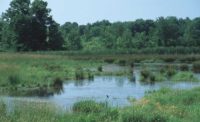Contractors, developers, farmers and landowners should be able to stand on a piece of property and easily identify which streams, ditches and ponds on the land fall under federal jurisdiction under a new proposed “Waters of the United States,” definition, according to EPA officials.
“Our simpler and clearer definition would help landowners understand whether a project on their property will require a federal permit or not, without spending thousands of dollars on engineering and legal professionals,” Andrew Wheeler, acting administrator for the Environmental Protection Agency said in a statement announcing the joint EPA and Army Corps of Engineers proposal on Dec. 11.
Among other things, the rule would categorically exclude water-filled ponds created in construction, most ditches, and wetlands that don’t have a direct surface connection to a navigable water.
But the rule may not be as simple as the EPA promises, and the path to finalizing the proposal, which is already generating controversy, make it unlikely there will be clarity on which waters will require federal permits anytime soon.
“That’s an overstatement,” says Larry Liebesman, senior adviser with water-resources consulting firm Dawson & Associates, of the claim that jurisdiction will be obvious on the ground. While the proposal does go far in clarifying and defining which waters are subject to federal jurisdiction, “There’s still a lot of room for technical expertise to figure out jurisdiction,” he says.
Still, contractors welcomed the news that there is a replacement for the Obama-era WOTUS on the horizon. EPA officials say they will try to get the rule finalized in the coming year, though it, like the Obama rule implemented in 2015, could be tied up for years in court battles.
“The new measure will enable contractors for all types of construction projects, from schools to local roadways and other infrastructure, to understand which permits they need and proceed without substantial regulatory delay and additional cost,” said Stephen E. Sandherr, CEO of the Associated General Contractors in a statement about the proposal. Sandheer said the 2015 rule, “would have required costly consultants to determine whether a job site was covered by the rule and also needed a federal water permit, and then figure out what impact that would have on their other environmental requirements.”
The American Road & Transportation Builders Association and the National Homebuilders Association, as well as business and farming interests released similar statements applauding the proposal, which was ordered by President Donald Trump in February 2017.
Nick Goldstein, assistant general counsel at ARBTA, says under the rules put in place by the Obama administration “everyone is operating under the worse-case scenario,” leading to delays in transportation projects as each roadside ditch is analyzed to determine if it is connected to a navigable waterway.
The confusion was exacerbated earlier this year when a nationwide stay on the 2015 rule was lifted and it went into effect in 22 states, but not in 28 others where it’s under separate court injunctions. Until the EPA finalizes its new rule, or a separate process to formally rescind the Obama rule, the current scattershot WOTUS regulation will remain in place.
‘Hydrology’ vs ‘Ecology’
The 2015 rule was put in place to settle confusion surrounding implementation of the Clean Water Act, which doesn’t clearly define what waters are under federal jurisdiction. Through the years, the Supreme Court and lower courts have issued opinions that have shaped how the rule is implemented. The most notable of these was the court’s 2006 decision in Rapanos v. United States. The split decision in that case led the federal government to decide on a case-by-case basis which waters are under its jurisdiction.
The Obama administration, in trying to clarify which rules are subject to jurisdiction, wrote a rule that leaned heavily on Justice Anthony Kennedy’s opinion in the Rapanos case. Kennedy concluded a water body that had a “significant nexus” to a navigable water that could impact its chemical, physical or biological integrity should be considered under federal jurisdiction.
Using that guidance, the 2015 rule covers “ephemeral,” waters that might appear only after a heavy rainstorm. Such ephemeral waters are often the only significant water sources in the West.
The Trump administration’s rewrite largely dismisses Kennedy’s significant nexus opinion, and instead is built around Judge Antonin Scalia’s opinion in the case that only “relatively permanent, standing or continuously flowing bodies of water,” are under federal jurisdiction.
The differences of the rules can be boiled down to ecology vs. hydrology, says Liebesman.
The Trump proposal defines that those relatively permanent waters consist of:
- Traditional navigable waters
- Tributaries that contribute perennial or intermittent flow to navigable waters
- Ditches that are navigable or are built within a tributary or wetland
- Some lakes and ponds
- Impoundments of navigable waters
- Wetlands that have a direct hydrologic surface connection to navigable water.
The rule also specifies which waters wouldn’t be under federal jurisdiction:
- Groundwater
- Ephemeral features that diffuse stormwater runoff
- The majority of ditches
- Artificially irrigated areas
- Prior converted cropland
- Artificial lakes and ponds
- Water-filled depressions created incidental to construction or mining and pits excavated for obtaining fill, sand and gravel
- Stormwater control features
- Wastewater recycling structures
- Waste treatment systems
The EPA says there are no numbers that quantify how much water will or won’t be regulated under the proposal. But a 2017 slideshow, prepared by the EPA and the Army Corps of Engineers, and obtained by E&E News through a freedom of information request, shows that 18% of streams and 51% of wetlands in the U.S. won’t be covered by the new rule.
Those water bodies might still be regulated by the states, and one key benefit EPA touts with the proposed rule is that it puts power back into states’ hands.
“It’s a recognition that the federal government is one of limited power,” Wheeler said in announcing the proposal.
Environmental groups say that lax state regulations and the resulting water pollution is what led to the creation of the Clean Water Act in the first place.
“Big polluters could not have crafted a bigger free pass to dump if they wrote it themselves,” Blan Holman, managing attorney for the Southern Environmental Law Center’s Charleston office said. “This administration’s efforts to dismantle the Clean Water Act are a full-frontal assault on one of our country’s most important and longstanding environmental safeguards that has prevented unchecked and unlimited pollution from contaminating our waterways and drinking water sources for nearly 50 years.”
Once the proposal appears in the Federal Register, the EPA and the Corps will take comments for 60 days. The agency will also hold an informational webcast on Jan. 10, and will host a listening session on the proposed rule in Kansas City, Kan., on Jan. 23.







Post a comment to this article
Report Abusive Comment